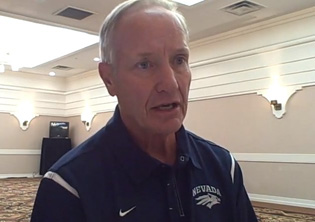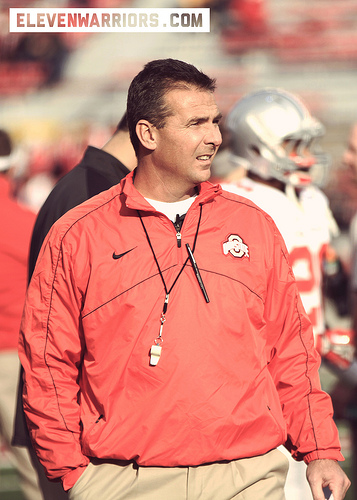Rarely does pro football emulate the college game. But that’s exactly what’s taking place in the NFL. The home of the West Coast offense and pocket-passing quarterbacks is giving way to the zone-read option and mobile signal-callers.
 Chirs Ault, the godfather of the pistol offense.
Chirs Ault, the godfather of the pistol offense.The spread read option was previously only seen in bits and pieces in the NFL. But shifty quarterbacks were all the rage during the 2012 NFL season. Robert Griffin III, Russell Wilson and Cam Newton have put an end to the age-old question, 'Is there a place for mobile quarterbacks in the NFL?’ And they’ve done so emphatically.
But the tour de force behind the movement is Colin Kaepernick. A lightly regarded three-star recruit, Kaepernick accepted the lone Division I scholarship offer he had – Nevada. It was in Reno that head coach Chris Ault discovered Kaepernick was the perfect quarterback to head his new pistol offense.
Ault had come up with the then-radical idea in 2005. The Wolf Pack were mired in a stretch of mediocrity and he believed the way out was through a new revolutionary offensive system. The idea would prove to be ingenious.
Running the football is central to any team’s success. Ault was aware of that and he also like having quarterbacks line up in the shotgun. Voila, he thought. The quarterback and running back could line up side-by-side. This would put the ball into the running back’s hands quicker or allow the quarterback to keep the ball based on what he saw defensively. No matter what, the offense would have the advantage and function more efficiently. Defenses would be indecisive and that slight hesitation could be the difference between a two-yard gain and a touchdown.
When Ault first presented the idea to fellow coaches around the country and his own staff, he said the reaction was one of bewilderment. His assistants thought it could be a career killer.
“I said, ‘Here’s what I want to do. Here’s what I want to do all spring. I want to try to reinvent something to give us our own identity,’” Ault said on The Herd on ESPN Radio. “I’m pretty sure when that meeting was over, they all went and got their resumes ready because they thought they weren’t going to be working here next year. It was that far out.”
Then spring practice came and the results didn’t exactly strike confidence into anyone.
“It was ugly,” Ault said. “The ball’s all over the place. The kids are thinking, ‘Oh, my God, hang on.’ But we never took a step backward. I never said we’re going back, because I felt we had to make a statement for our university to try to get its own identity. If it didn’t work, I’d step aside and say get back to the other stuff.”
There was no need for a new coaching staff, not after Nevada went 9-3 and won the WAC and the Hawaii Bowl during the 2005 season. Over the next eight seasons, after the change to the pistol, Nevada went 65-39, won two conference titles and went to a bowl game every season. The high point was a 13-1 record and No. 11 final ranking in 2010.
 Meyer has used the zone read to rack up wins.
Meyer has used the zone read to rack up wins.During Kaepernick’s four-year reign of terror, he was twice named WAC offensive player of the year. He also became the first – and still only – FBS quarterback to throw for over 10,000 yards and rush for more than 4,000 yards in a career. Kaepernick also is the lone quarterback to pass for over 2,000 yards and rush for over 1,000 yards in a single season three times in a career.
It was those numbers and the extreme athleticism Kaepernick possesses that attracted Jim Harbaugh to him. During the 2011 NFL Draft, San Francisco traded up in the second round, giving Denver three draft picks, just to get Kaepernick.
It’s a decision the 49ers haven’t regretted.
The returns on Kaepernick were not immediate. He played well in a wildcat role during his rookie season, but the 49ers used him sparingly. The re-emergence of Alex Smith put Kaepernick’s development on the backburner. The offseason courting of Peyton Manning made it look like Kaepernick’s career would take more years to get off the ground. But Manning opted for the Broncos and a midseason concussion sidelined Smith, giving Kaepernick his first NFL start. He’s started every game since and will do so again when San Francisco plays Baltimore in the Super Bowl next Sunday.
Kaepernick is 7-2 as a starter, but what really got people’s attention was his performance in the playoffs against Green Bay. He rushed for a quarterback playoff-record 181 yards and two touchdowns and added 17 completions for 263 yards and two more scores. All told, the 49ers' offense, headed by Kaepernick, rolled up 579 yards of offense.
NFL defenses, chock full of some of the world’s best athletes, have been completely dumbfounded by Kaepernick’s (and RGIII) ability to execute the zone-read option. Defensive linemen that weigh as much as dump trucks and linebackers than run 4.4 40s are the first lines of defense. But arithmetic still applies in the NFL, and read plays re-order that arithmetic back towards the offense. For that, they can thank the likes of Ault and Urban Meyer.
“There’s times where you look at things and think if you should have done something, but no regrets on that,” Ault said. “It was fun taking (Nevada) to where we are and creating the pistol, and seeing that go to the NFL is really a special thrill.”
Ironically, fundamentals betray NFL teams in limiting the effectiveness of the zone read. Linebackers are taught to crash the line of scrimmage, which works wonderfully against a traditional offense. But against the zone read, it makes them vulnerable to being out of position and missing tackles. Tyler Replogle understands the nuances of slowing down the pistol and zone read; Clay Matthews does not.
In the NFL’s history, the term "running quarterback" wasn’t always in a literal sense. Steve Young and Michael Vick are pass-first quarterbacks that scrambled from time to time. Kaepernick, RGIII, Wilson and Newton run frequently – and it is often by design. Kaepernick has the 49ers positioned for a sixth Super Bowl title, Griffin led the Redskins’ offense to a league-best 6.2 yards per play this season, Wilson and the Seahawks were this close to being in the NFC Championship Game, and Newton had one of the best rookie seasons ever in 2011.
The evolution of the quarterback has steered the direction of football since the sport’s founding sevenscore and four years ago. It is easy to forget that every NFL team ran the 'single wing.' The ball was directly snapped to the tailback who would run or throw. The 'quarterback' position was little more than a blocking back (hence the use of the term 'quarter'--they were closer to the line of scrimmage). But that all changed in the 1940 NFL championship, when Sid Luckman and the Chicago Bears unveiled the 'T' formation in a 73-0 demolishing of the Washington Redskins. Ever since then, the NFL generally put their quarterbacks under center, where their role was to pass or hand off.
College football has a more schematically varied past. It evolved during the age of the option and wishbone before giving way to pass heavy offenses, until finally the age of the dual-threat quarterback emerged. The grand showcase for the new age quarterback is Super Bowl XLVII. That Baltimore is the defense faced with slowing the attack is appropriate. For more than a decade, the Ravens have been the gold standard of barricades.
For the next week, Baltimore Ravens head coach John Harbaugh will try his darndest to understand how brother Jim makes his offense go. In Columbus, Ohio, Meyer will be doing the same. But he doesn’t want to learn how to stop it. For the next seven months, like he often does, Meyer will be searching for any wrinkle he can find to stay ahead of and catch the competition.
“I haven’t watched much pro football,” said Meyer, on a recent addition of the Dan Patrick Show. “I saw some highlights that looked exactly like the stuff we run. It’s phenomenal. It’s pure spread offense. That means you’re reading one defender, and the quarterback is, in essence, a ball-carrier if the defender reacts a certain way.”
Some new offensive variations also sprung up as Meyer tuned in to NFL games. One such wrinkle was used by San Francisco, where the h-back blocking across the line of scrimmage would also read the defensive end and either kick him out or avoid him, depending on his actions. Meyer said the Buckeyes would be doing the same thing in the fall.
Meyer owes much of his success to high-powered offenses. In both national championship seasons at Florida, the zone read resulted in flustered defenses. The same can be said for Ohio State quarterback Braxton Miller in Year 1 under Meyer. The Big Ten’s offensive player of the year could run, pass or handoff. Regardless of what he did, opponents were largely confused. Miller finished the season with nearly 1,300 yards rushing and 13 touchdowns.
The most effective defenses were at slowing Miller was when he suffered injuries. Therein lies the rub with having mobile quarterbacks. RGIII’s injury in the playoffs is the most high-profile case yet. He suffered a serious knee injury and could miss part of next season.
“How long can you go taking shots like that?” Meyer said. “That will be the question with how long you can use that style offense.”
The answer: until defenses stop it.

